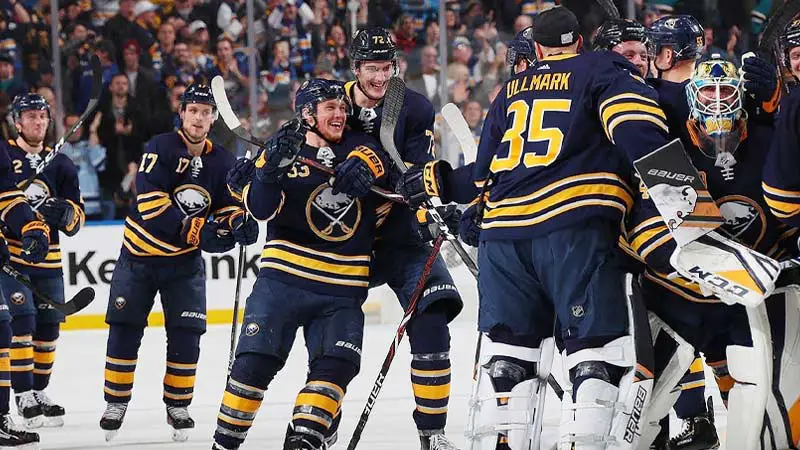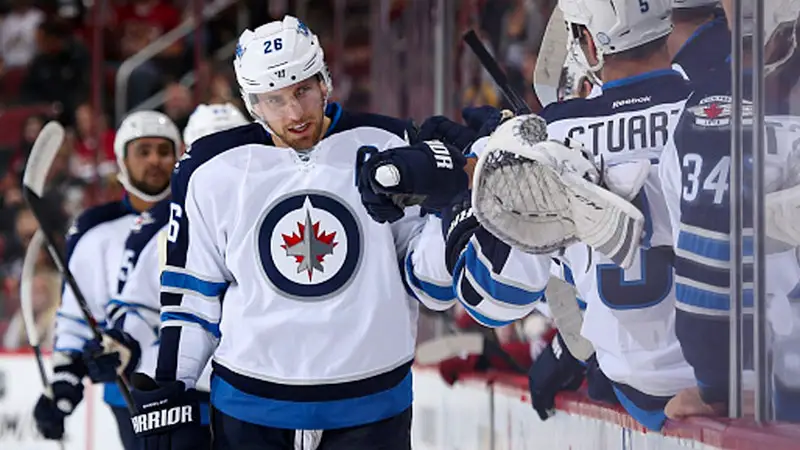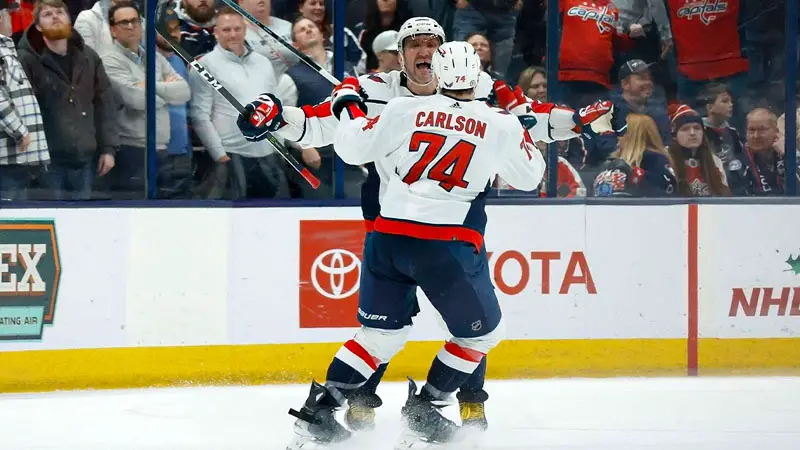Embarking on the thrilling extra innings of a hockey game, understanding how hockey overtime works unravels a suspenseful layer of the sport.
When regular play concludes in a tie, teams enter an overtime period with a sudden-death format. The primary objective is clear: be the first to score and seize victory.
Overtime introduces a strategic twist with a reduction in player strength, often transitioning from 5-on-5 to 3-on-3 or 4-on-4, amplifying the intensity and fostering dynamic plays.
For games still deadlocked after overtime, the intrigue extends to shootouts, where individual skills take center stage in a quest for that decisive goal.
Points earned during these overtime escapades significantly impact team standings, adding a competitive edge.
In the realm of hockey over time, the interplay of strategy, reduced player configurations, and the potential for shootouts create a captivating spectacle for fans and players alike.
So, lace up your virtual skates, dive into player analytics, and embark on a thrilling journey on how hockey overtime works. Stay focused.
The Basics of Hockey Overtime
Hockey over time, a captivating extension of regular play, introduces unique dynamics that amplify the thrill of the game.
Typically occurring when a match ends in a tie, overtime is a sudden-death scenario where the first team to score clinches victory.
The player configuration often shifts from the standard 5-on-5 to 3-on-3 or 4-on-4, creating a faster and more open-paced spectacle.
Coaches strategically deploy players to exploit the additional space, making for dynamic and intense gameplay.
If neither team scores during the designated overtime period, a shootout ensues, where individual skills take center stage.
Points earned in overtime contribute to team standings, reinforcing the competitive spirit.
In the exciting realm of hockey over time, the blend of strategic maneuvering reduced player strength, and the potential for shootouts adds an extra layer of complexity and excitement to the sport.
How Does Hockey Overtime Work?
Navigating the thrilling territory beyond regulation play, understanding how hockey overtime works unveils a dynamic and strategic facet of the game.
Here’s a breakdown of the key elements that define the overtime period in hockey:
Sudden Death Overtime

Hockey overtime employs a sudden-death format, meaning the first team to score during the extra period secures the victory.
This adds a heightened sense of urgency and excitement as teams battle to end the game decisively.
Reduced Player Strength
Overtime often features a reduction in player strength on the ice.
Teams typically switch from the regular 5-on-5 configuration to 3-on-3 or 4-on-4, creating more open space and fostering fast-paced, high-intensity gameplay.
Overtime Intermissions
Overtime consists of one or more intermissions depending on the league.
Teams may regroup, strategize, and make necessary adjustments during these brief breaks, adding an extra layer of anticipation to the overtime period.
No Shootouts in Certain Leagues
While many leagues conclude overtime with a shootout if no goals are scored, some leagues, like the NHL during the regular season, use shootouts only if the tie persists after the overtime period.
In other leagues or playoff scenarios, continuous overtime periods may be employed until a goal is scored.
Points Distribution
Teams are awarded points based on the outcome of the game. The team that scores during overtime, be it in 3-on-3 play or a shootout, earns two points.
The losing team still secures one point, promoting competitiveness even in defeat.
Format of Hockey Overtime

Unveiling the unique format that adds an extra layer of excitement to hockey games, the overtime period brings a distinct set of rules and dynamics.
Here’s a detailed exploration of the format of hockey overtime:
Sudden Death Determination
Hockey overtime operates on a sudden-death principle, meaning the first team to score during the extra period clinches the victory.
This format intensifies the pressure on players and emphasizes swift, strategic gameplay.
Reduced Player Configuration
The traditional 5-on-5 player configuration gives way to a reduced format in overtime, commonly 3-on-3 or 4-on-4.
This alteration creates more open ice and accelerates the pace of the game, fostering dynamic offensive plays and increased scoring opportunities.
Intermissions and Strategy
Overtime periods may include one or more intermissions, providing teams with brief moments to regroup, strategize, and make necessary adjustments.
These breaks contribute to the tactical dimension of overtime, as coaches and players adapt to the evolving dynamics on the ice.
Shootouts as a Tiebreaker (Varies by League)
In certain leagues, if neither team scores during the designated overtime period, a shootout follows to determine the winner. Each team selects players to take penalty shots against the opposing goaltender.
However, rules regarding shootouts may vary between leagues, with some leagues employing continuous overtime until a goal is scored.
Points Distribution
The points awarded in overtime contribute to the overall standings. The team that scores the winning goal during overtime, whether in regular play or a shootout, earns two points.
The losing team, even if defeated in overtime, secures one point. This structure encourages teams to compete fiercely, knowing that even in defeat, they can gain a valuable point.
Understanding the format of hockey over time adds depth to the spectator experience, providing a glimpse into the strategic maneuvers and thrilling moments that define these crucial periods of play.
The Shootout Format in Hockey Overtime

Delving into the climactic conclusion of hockey overtime, the shootout format adds a dramatic twist to the game, bringing individual skills to the forefront.
Here’s an in-depth look at the shootout format in hockey overtime:
Post-Overtime Tiebreaker
When the standard overtime period concludes without a decisive goal, a shootout serves as the tiebreaker to determine the winner.
This phase provides an electrifying one-on-one contest between shooters and goaltenders.
Player Selection
Each team selects a predetermined number of players to participate in the shootout.
These players showcase their skills in a series of penalty shots against the opposing goaltender, aiming to score and secure the victory for their team.
Time Limit on Attempts
Shootouts typically have a time limit for each shooter’s attempt, adding an element of urgency.
The player starts from a designated spot and has a set duration to navigate towards the goal, showcasing their puck-handling skills and attempting to beat the goaltender.
Goalie Strategies
Goaltenders play a pivotal role in shootouts, employing various strategies to thwart incoming shooters.
Quick reflexes, reading the shooter’s movements, and staying composed under pressure are essential skills for goaltenders during this intense phase of play.
Determining the Winner
The team with the most goals at the end of the shootout is declared the winner.
If the shootout remains tied after the initial round, additional rounds occur until one team secures the decisive advantage, offering a nail-biting spectacle for fans.
Overtime Tiebreakers in Hockey
In the dynamic world of hockey, tiebreakers during overtime serve as the pivotal moments that determine the outcome of closely contested games.
Here’s an exploration of the various overtime tiebreakers in hockey:
Sudden Death Overtime
The primary tiebreaker in hockey is the sudden death overtime period. In this format, the first team to score during the extra period secures the victory.
The sudden-death principle adds an element of urgency and excitement, as every play has the potential to be the game-winner.
Reduced Player Configuration
To increase scoring opportunities and create a more dynamic playing environment, overtime often features a reduction in player strength on the ice.
Teams commonly switch from the regular 5-on-5 configuration to 3-on-3 or 4-on-4, introducing a fast-paced and strategic element to the game.
Shootouts
If the sudden death overtime period concludes without a decisive goal, many leagues implement shootouts as a tiebreaker.
Each team selects players to take penalty shots against the opposing goaltender, with the team scoring the most goals declared the winner.
Shootouts showcase individual skills and provide a thrilling conclusion to tied games.
Continuous Overtime (Varies by League)
In certain leagues, particularly during playoff scenarios, continuous overtime may be employed as a tiebreaker.
Teams play additional overtime periods until a goal is scored, determining the winner through extended play. This format ensures a conclusive outcome without resorting to a shootout.
Points Distribution
Points awarded during overtime contribute to the overall standings.
The team that scores the winning goal, whether in sudden death, a shootout, or continuous overtime, earns two points, while the losing team secures one point.
This system encourages teams to compete fiercely, even in the event of defeat.
Understanding the various overtime tiebreakers in hockey adds depth to the appreciation of the sport, showcasing the strategic elements and thrilling moments that unfold when games reach a deadlock.
FAQs
How long is the overtime period in hockey?
In the NHL, the regular-season overtime period is 5 minutes. If no goal is scored, a shootout follows.
During playoffs, overtime periods are 20 minutes each, and continuous sudden-death play persists until a goal determines the winner.
Can a team change their players during overtime?
Yes, teams can make player changes during overtime. The reduced player configuration, often 3-on-3, allows for strategic substitutions as coaches adapt to the dynamic nature of the game.
What happens if a game is still tied after overtime?
In the regular season, if a game remains tied after overtime, the NHL employs a shootout to determine the winner. Each team selects players to take penalty shots until one team scores more goals.
Do points earned in overtime impact the standings?
Yes, points earned in overtime impact team standings. The winning team in overtime or a shootout earns two points, while the losing team secures one point.
This encourages competitiveness even in games that extend beyond regulation play.
Why does hockey use a shootout in overtime?
The shootout is used to provide a decisive winner when the standard overtime period ends in a tie.
It adds excitement, showcases individual player skills, and ensures a clear outcome for games that remain deadlocked after the overtime period.
Wrapping Up
In the intricate dance of hockey over time, the blend of sudden-death drama, reduced player strength, shootouts, and points distribution paints a canvas of excitement.
Teams navigate the intensity, coaches deploy strategic maneuvers, and players showcase their skills in the pursuit of a decisive victory.
Whether through the thrill of a shootout or continuous sudden-death play, hockey over time encapsulates the essence of the sport, unpredictable, fast-paced, and rife with strategic depth. Thank you so much.








James Felix